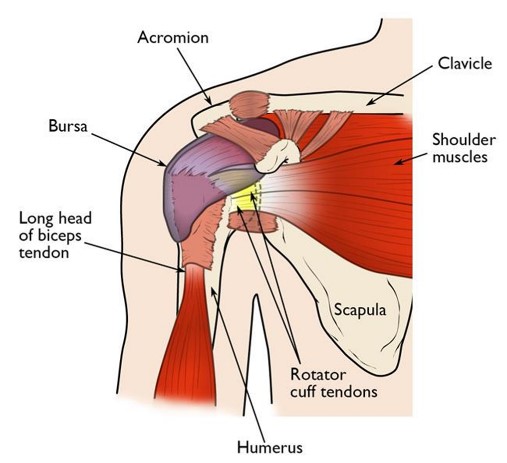By Snehal C. Dalal, M.D., OrthoAtlanta
Shoulder pain is one of the most common physical complaints faced by tennis players. Consisting of several joints combined with tendons and muscles, the shoulder enables a great range of motion and strength in the arm, but we ask a lot of this complex structure, particularly in tennis.
The dreaded rotator cuff tear is most feared, but seemingly less serious conditions, such as tendonitis, bursitis and shoulder impingement can take a tennis player off his or her game – and ultimately out of the game – if not diagnosed correctly, treated properly and allowed the appropriate time to heal.
 Activities that require repeated overhead arm movements, such as overhand tennis serves, often can bring about injury to the shoulder that irritate and cause inflammation. Dynamic instability (loosening) of the shoulder, typically caused over time by repetitive overhead activity, trauma, previous injury, poor posture or inactivity can cause your rotator cuff to work harder, causing injury. Training too hard is a common cause of overuse injury to the shoulder.
Activities that require repeated overhead arm movements, such as overhand tennis serves, often can bring about injury to the shoulder that irritate and cause inflammation. Dynamic instability (loosening) of the shoulder, typically caused over time by repetitive overhead activity, trauma, previous injury, poor posture or inactivity can cause your rotator cuff to work harder, causing injury. Training too hard is a common cause of overuse injury to the shoulder.
Overuse injuries can vary from mild tendon inflammation (tendonitis), bursitis (inflamed bursa), shoulder impingement (pinching and irritation of the soft tissues or against bone), calcific tendonitis (bone forming within the tendon) through to partial and full thickness rotator cuff tendon tears. Concentrating on shoulder impingement, I will describe its causes, symptoms and the best treatment options.
Shoulder impingement can present the following common symptoms: local swelling and tenderness in the front of the shoulder; an arc of shoulder pain when your arm is at shoulder height and/or overhead; shoulder pain that can extend from the top of the shoulder to the elbow; minor pain present with activity or at rest; muscle weakness or sudden pain when reaching or lifting; and pain when putting your hand behind your back or head.
A thorough physical examination by a trained orthopedic specialist will identify shoulder disorders and appropriate treatment. Symptoms, medical history and activity level will first be discussed. The physician then will evaluate range of motion as you move your arm in several directions and test arm strength. Typically, a comparison will be made to your other arm and shoulder. Shoulder pain also can be caused by neck or spine conditions, such as a pinched nerve, so this also will be considered during a thorough exam.
Diagnostic tests, if needed, typically include MRI and ultrasound since these scans provide better images of soft tissue to look for tears in the rotator cuff or signs of bursitis. X-ray may be useful to identify broken bones.
In most cases, initial treatment of shoulder impingement is nonsurgical with patients typically experiencing gradual improvement and return to function after several weeks or months. Nonsurgical treatments may include:
- Rest – Reduced activity, including avoiding overhead actions for a period.
- Medication – Nonsteroidal anti-inflammatory medications (NSAIDs) to reduce pain and swelling.
- Physical therapy – Stretching exercises to improve range of motion; exercises will be expanded to include strength training, but not before a prescribed period to avoid further or return injury.
- Steroid injections – If rest, medications and physical therapy do not relieve the pain, cortisone can be a very effective anti-inflammatory for many people.
When nonsurgical treatment does not relieve pain, either arthroscopic or traditional open surgery may be recommended to create more space for the rotator cuff. An inflamed portion of the bursa may be removed. Or, in a procedure known as subacromial decompression, a portion of the acromion is removed.
Less invasive arthroscopic surgery is a frequently used technique for shoulder impingement. The doctor examines your shoulder through a fiberoptic scope connected to a television camera. Small instruments are used to remove bone and soft tissue. Other conditions may be treated during this arthroscopic procedure, such as arthritis, biceps tendonitis or even a partial rotator cuff tear. Some shoulder conditions require traditional open surgery. A small incision in the front of the shoulder allows access to the acromion and rotator cuff to complete the needed repair.
After surgery, your arm may be placed in a sling for a period. As pain subsides, your physician will have you begin exercises and use of the arm. A staged series of physical therapy steps will aid the healing process and return to function, while avoiding re-injury. Typical recovery is two to four months, but for some, it may take up to a year. It is important to follow the recovery program to avoid reinjury.
When facing sudden or repeated shoulder pain, a trained orthopedic specialist can determine the cause of your shoulder pain and provide you with treatment options.
Snehal C. Dalal, M.D., OrthoAtlanta, is a board-certified orthopedic surgeon. He is co-medical director for the annual BB&T Atlanta Open. He also serves as a sideline physician for the Chick-fil-A Peach Bowl and Chick-fil-A Kickoff Games. Dr. Dalal sees patients at OrthoAtlanta Gwinnett and Johns Creek locations.




